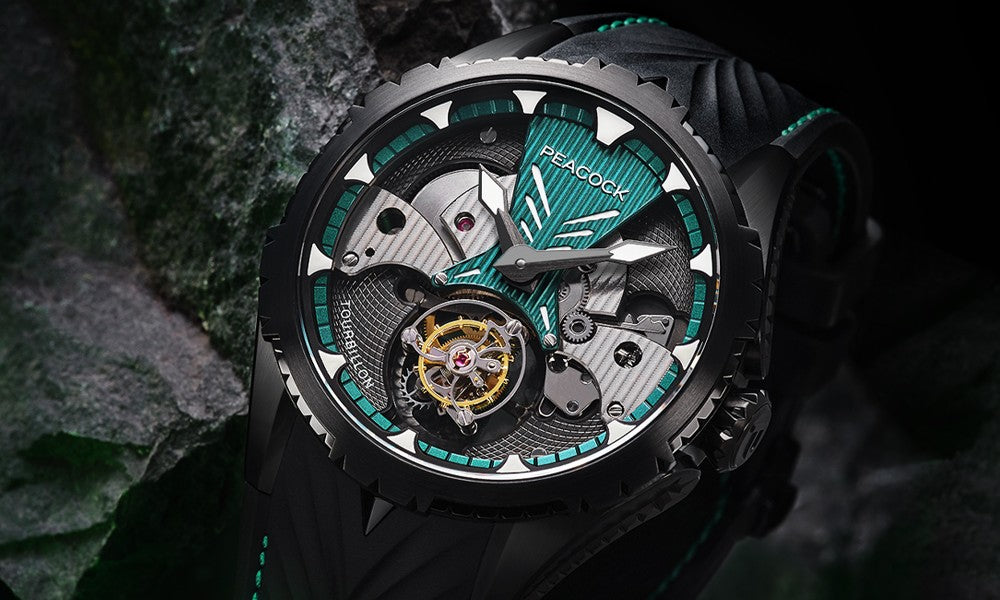The world of horology is filled with intricate mechanisms and fascinating complications, but few are as captivating as the tourbillon.
What is a Tourbillon?
A tourbillon, French for “whirlwind”, is a captivating feature in high-end mechanical watches. Invented in 1795 by Abraham-Louis Breguet, the tourbillon’s primary aim was to enhance accuracy by counteracting gravity-induced errors in timekeeping.
In horology, a tourbillon is an addition to the mechanics of a watch escapement to increase accuracy. In a tourbillon, the escapement and balance wheel are mounted in a rotating cage, with the goal of eliminating errors of poise in the balance giving a uniform weight. This rotation, typically once per minute, offsets the positional errors caused by gravity, thus improving the watch’s accuracy.
The tourbillon is a symbol of craftsmanship and prestige. The complexity of its design and the skill required to assemble it make the tourbillon a coveted feature in luxury watches. Watching a tourbillon in motion is a mesmerizing sight, a testament to the artistry of watchmaking.
Innovations in materials and design have led to new variations of the tourbillon, such as the flying tourbillon and the multi-axis tourbillon, ensuring this fascinating complication remains at the forefront of horological innovation.
How Does a Tourbillon Work?
A tourbillon is a complex mechanism designed to enhance the accuracy of mechanical watches by counteracting the effects of gravity.
At its most basic level, a tourbillon is a rotating cage that contains the entire balance with its spring, escape wheel, and lever. This cage is usually connected to and powered by the fourth wheel, which is responsible for displaying the seconds on a small seconds dial. Both the fourth wheel and the tourbillon make one full rotation per minute. This rotation offsets any gravity-related deviations and guarantees the highest possible level of accuracy.
There are different types of tourbillons, such as the single-axis tourbillon, double-axis tourbillon, and the flying tourbillon. Each of these types has its own unique characteristics and complexities
The Artistry of the Tourbillon
The tourbillon is not just a technical marvel, but also a work of art in the realm of horology. Here’s why:
- Craftsmanship: The creation of a tourbillon requires exceptional skill and precision. Each component must be meticulously crafted and assembled, often by hand, by experienced watchmakers. This level of craftsmanship is a testament to the artistry involved in watchmaking.
- Aesthetics: The tourbillon is often exposed on the watch’s dial, allowing the wearer to appreciate its intricate mechanics in motion. The rotating cage offers a captivating visual spectacle, adding to the watch’s aesthetic appeal.
- Exclusivity: Due to the complexity and skill required to create a tourbillon, they are often found in high-end, luxury watches. Owning a tourbillon watch is seen as a symbol of sophistication and an appreciation for the art of watchmaking.
- Innovation: The tourbillon continues to inspire innovation in design and engineering. Variations such as the flying tourbillon and multi-axis tourbillon showcase the ongoing creativity and advancement in the field.
In essence, the tourbillon represents the perfect blend of form and function, where technical excellence meets artistic expression. It’s a testament to the enduring allure and fascination of mechanical watchmaking.
Notable Tourbillon Watches
Tourbillon watches are produced by several high-end watch manufacturers, including Patek Philippe, Audemars Piguet, and Vacheron Constantin. These timepieces are often characterized by their exquisite design, precision engineering, and, of course, hefty price tags. There are also some notable Chinese Tourbillon watch brands at fairer prices, like Seagull Watches, Peacock Watches, and Beijing Watches.
The Future of the Tourbillon
While the tourbillon was invented over two centuries ago, it continues to captivate watch enthusiasts and collectors. Innovations in materials and design have led to new variations of the tourbillon, such as the flying tourbillon and the multi-axis tourbillon, ensuring this fascinating complication remains at the forefront of horological innovation. Its future seems promising due to the following reasons:
- Continued Innovation: The tourbillon has inspired continuous innovation in design and engineering. New variations such as the flying tourbillon and multi-axis tourbillon showcase the ongoing creativity and advancement in the field.
- Adaptation to Modern Styles: While some believe that the tourbillon should remain within a classical setting, others revel in the fact that this "ancient" device can delight a new and younger crowd, set in dazzling colors and out-there, alien-spaceship-like cases. This adaptability to modern styles ensures the tourbillon's relevance in contemporary watchmaking.
- Symbol of Craftsmanship: The tourbillon continues to be a symbol of craftsmanship and prestige. As long as there is an appreciation for the art of watchmaking, the tourbillon will continue to hold its place of honor.
- New Collaborations: The future of the tourbillon also lies in new collaborations. For instance, the new Battista Tourbillon from BOVET 1822 and Automobili Pininfarina is a result of a collaboration that celebrates the past of both Houses and has its sights firmly set on the next century.
In conclusion, the tourbillon, with its blend of technical excellence and artistic expression, is indeed future-proof¹. It's expected to remain at the forefront of horological innovation, continuing to fascinate and captivate watch enthusiasts around the world.

